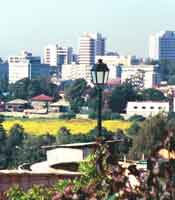Interesting facts on Ethiopia, its cities, peoples, culture, history, languages, climate, currency, different times, in fact everything Ethiopia.
Ethiopia is one of the few African countries never to lose its independence.
It is as large as France and Spain combined and has one of the richest histories on the African continent.
Ethiopia voted sixth in Frommer's Top Travel Destinations for 2007
Frommer's, best known for their travel guides, have been a source of travel expertise for 50 years. After surveying their authors and travel experts, Ethioipia emerged as one of the top places not to be missed in 2007.
Frommer's said of Ethiopia: "Improved infrastructure has made traveling there increasingly popular, especially among independent-minded travelers and those seeking adventure."
Government
Ethiopia is an independent Federal Democratic Republic with a President as head of state and a Prime Minister as the head of government. It has a number of distinct regional states – Tigray, Afar, Amhara, Oromia, Somali, Benishangul-Gumuz, Southern Nations (SNNPS), Gambella and Harari.
Addis Ababa
The capital, whose name means "New Flower", was settled in 1886 and given its name by Empress Taytu, consort of Menelik II. The population of Addis Ababa is approximately 3 million.
 Addis Ababa is situated at over 2,500 metres above sea level and adjusting to the altitude can take some visitors a little time, so don't be surprised if you find things tiring.
Addis Ababa is situated at over 2,500 metres above sea level and adjusting to the altitude can take some visitors a little time, so don't be surprised if you find things tiring.
Depending on your level of fitness you might also experience a shortness of breath, headaches and possibly nausea until you are acclimatized.
At high altitude your breathing may become more rapid and shallow causing increased dehydration, so you should drink plenty of water and avoid alcohol.
Cities and Towns
The second largest city in Ethiopia is Dire Dawa, with an estimated population of 330,000. Gondar is the third largest town, with a population of some 150,000 people.
Ethiopian Facts
Land Mass: 1,119,683 sq km
Covered by Water: 7,444 sq km
Lowest point: Denakil Depression -125 m
Highest point: Ras Dejen 4,620 m
People
Ethiopia has a total population estimated at approximately 70 million and is home to more than 80 ethnic groups and a wide diversity of languages.
Ethiopia was never colonised, even though from 1935-1941 it was occupied by Mussolini’s Fascists it has remained untainted by colonial powers.
Religion
The major religions are Christianity (mainly Orthodox Church) and Islam.
Language
Amharic is the official language of Ethiopia, although English, Italian, French and Arabic are also widely spoken. Outside the larger cities and towns, indigenous languages are likely to be spoken - of which there are over eighty, along with some 200 dialects. The most common of these are Oromo, Tigrinya and Somali.
In the northern and central parts Ethiopia different Semitic languages are spoken. Namely Tigre, Tiginrya, Guraginya and the official national language Amharic. The root of these languages, Ge'ez, only survives today in church liturgy and literature.
The Sidama languages are spoken to the south-east and to the east and parts of the south are the Cushitic-speaking peoples of the Oromos, the Afars and the Somalis.
To the west and south-west are the Nilotic peoples with their own distinctive language and culture.
In other areas of the country there are smaller communities whose cultures, languages and traditions derive from different facets of Ethiopia's long history.
Ethiopian Facts
Ethnic groups: Oromo 40%, Amhara and Tigre 32%, Sidamo 9%, Shankella 6%, Somali 6%, Afar 4%, Gurage 2%, other 1%
Religions: Muslim 45%-50%, Ethiopian Orthodox 35%-40%, animist 12%, other 3%-8%

